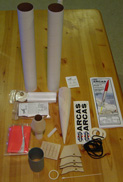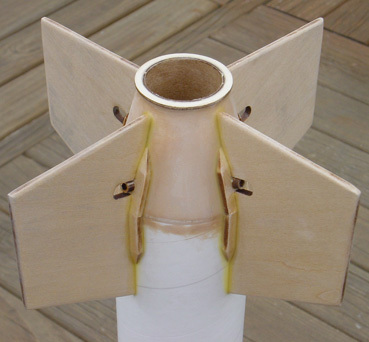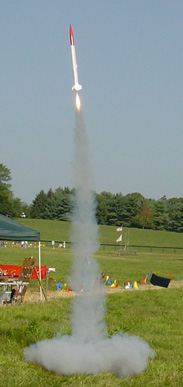 Brief:
Brief:
A 1/2 scale model of the Atlantic Research Corporation sounding rocket produced in the 1950s and 1960s.
Construction:
The kit contains two BTH-70 sized body tubes, laser cut basswood fins, and balsa nose and tailcones. The motor mount is 29 mm with plywood centering rings. Fin assemblies also include root plates and hex bolt heads that are to be glued to the root plates. A baffle and a 24 inch nylon parachute are included. A 24 mm engine mount adapter is included. All components are high quality.
 The kit instructions are straight forward and allow for the option of building this kit to launch on up to high power H motors. Overall this is an easy build with the highlight being the fin and tail cone assembly. Use of epoxy on centering rings, fins and engine mount is recommended if the model is intended for high power applications. Since this is a scale kit the directions provide fin dimension for sanding the cross section to scale. In and effort to save time sanding when preparing the basswood fins, I elected to sand my fins with only rounded leading and trailing edges. The fins also have cut-outs along the root edge where the simulated bolt heads are attached. Although I used epoxy on the centering rings, for the rest of the fins and tailcone assembly, I used wood glue and the result was surprisingly rigid. Since the kit is promoted as being able to fly on up to H motors, I thought the 3/16 inch lugs were small for this kit and decided to use 1/4 inch lugs. Approximately 5 1/2 feet of tubular elastic shock cord was provided to which I added another 3 feet of elastic cord. One item to note is that with the balsa tail cone there is no allowance for use of positive retention methods. I, myself, am a fan of friction fitting even when using 29 mm composite motors.
The kit instructions are straight forward and allow for the option of building this kit to launch on up to high power H motors. Overall this is an easy build with the highlight being the fin and tail cone assembly. Use of epoxy on centering rings, fins and engine mount is recommended if the model is intended for high power applications. Since this is a scale kit the directions provide fin dimension for sanding the cross section to scale. In and effort to save time sanding when preparing the basswood fins, I elected to sand my fins with only rounded leading and trailing edges. The fins also have cut-outs along the root edge where the simulated bolt heads are attached. Although I used epoxy on the centering rings, for the rest of the fins and tailcone assembly, I used wood glue and the result was surprisingly rigid. Since the kit is promoted as being able to fly on up to H motors, I thought the 3/16 inch lugs were small for this kit and decided to use 1/4 inch lugs. Approximately 5 1/2 feet of tubular elastic shock cord was provided to which I added another 3 feet of elastic cord. One item to note is that with the balsa tail cone there is no allowance for use of positive retention methods. I, myself, am a fan of friction fitting even when using 29 mm composite motors.
 Finishing:
Finishing:
The color scheme on the cover art shows the round pictured in NASA photo 63-Arcas-1. The red and white color scheme presents a bit of a challenge in trying to match the curvature of the red nose section and vertical striping. I elected to fill the fins and nose cone with sanding sealer and the tailcone with Elmer’s Fill-N-Finish®. After primering and sanding, I was pleased at the two colored finish. The large black lettered ARCAS decal was easy to apply.
Construction Rating: 5 out of 5
Flight:
Recommended motors are D12-3 through H128-10
The included baffle is a plus for ease of flight preparation that is somewhat offset by the required friction fitting motor retention. An added wrap of tape at the engine tailcone joint is made difficult by the aft tail ring, so give the motor a good tug to make sure it is secure.
I first flew the Arcas at NARAM 50 on an E16-4W. This flight was relatively slow lifting off to about a 700 foot altitude. Subsequent flights on F20-7W and F21-8R Econojet motors provided much quicker liftoffs, straight as an arrow to impressive altitudes of over 1000 feet. If launching on an H motor expect flights well in excess of 2000 feet.
 Recovery:
Recovery:
The 24 inch parachute provides a slow decent so if launching with larger motors, expect some drifting.
Flight Rating: 4 out of 5
Summary:
A striking large mid power kit, with excellent Semroc quality and value. The tailcone and fin assembly are a conversation piece.
Overall Rating: 5 out of 5

 Brief:
Brief: The kit instructions are straight forward and allow for the option of building this kit to launch on up to high power H motors. Overall this is an easy build with the highlight being the fin and tail cone assembly. Use of epoxy on centering rings, fins and engine mount is recommended if the model is intended for high power applications. Since this is a scale kit the directions provide fin dimension for sanding the cross section to scale. In and effort to save time sanding when preparing the basswood fins, I elected to sand my fins with only rounded leading and trailing edges. The fins also have cut-outs along the root edge where the simulated bolt heads are attached. Although I used epoxy on the centering rings, for the rest of the fins and tailcone assembly, I used wood glue and the result was surprisingly rigid. Since the kit is promoted as being able to fly on up to H motors, I thought the 3/16 inch lugs were small for this kit and decided to use 1/4 inch lugs. Approximately 5 1/2 feet of tubular elastic shock cord was provided to which I added another 3 feet of elastic cord. One item to note is that with the balsa tail cone there is no allowance for use of positive retention methods. I, myself, am a fan of friction fitting even when using 29 mm composite motors.
The kit instructions are straight forward and allow for the option of building this kit to launch on up to high power H motors. Overall this is an easy build with the highlight being the fin and tail cone assembly. Use of epoxy on centering rings, fins and engine mount is recommended if the model is intended for high power applications. Since this is a scale kit the directions provide fin dimension for sanding the cross section to scale. In and effort to save time sanding when preparing the basswood fins, I elected to sand my fins with only rounded leading and trailing edges. The fins also have cut-outs along the root edge where the simulated bolt heads are attached. Although I used epoxy on the centering rings, for the rest of the fins and tailcone assembly, I used wood glue and the result was surprisingly rigid. Since the kit is promoted as being able to fly on up to H motors, I thought the 3/16 inch lugs were small for this kit and decided to use 1/4 inch lugs. Approximately 5 1/2 feet of tubular elastic shock cord was provided to which I added another 3 feet of elastic cord. One item to note is that with the balsa tail cone there is no allowance for use of positive retention methods. I, myself, am a fan of friction fitting even when using 29 mm composite motors. Finishing:
Finishing: Recovery:
Recovery:





M.G. (August 16, 2008)